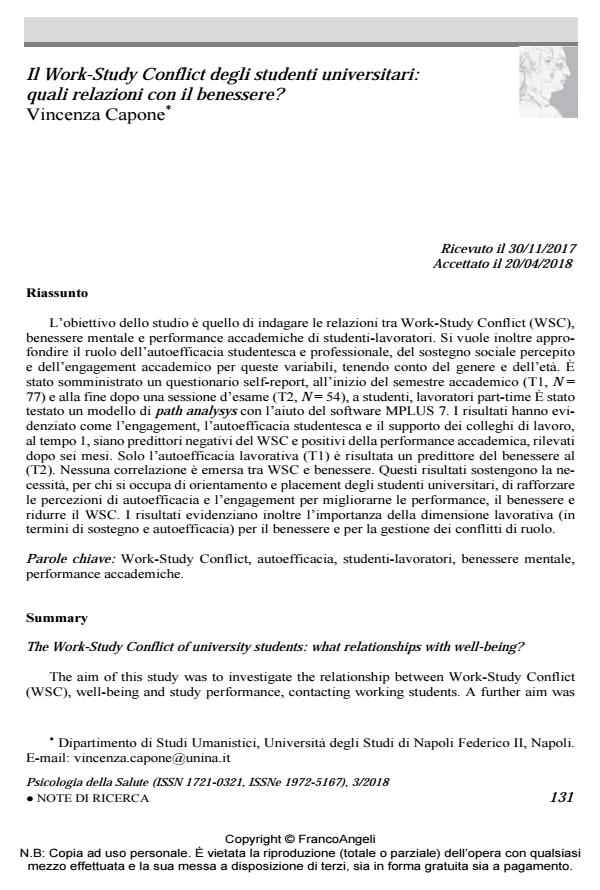The Work-Study Conflict of university students: what relationships with well-being?
Journal title PSICOLOGIA DELLA SALUTE
Author/s Vincenza Capone
Publishing Year 2018 Issue 2018/3
Language Italian Pages 14 P. 131-144 File size 280 KB
DOI 10.3280/PDS2018-003007
DOI is like a bar code for intellectual property: to have more infomation
click here
Below, you can see the article first page
If you want to buy this article in PDF format, you can do it, following the instructions to buy download credits

FrancoAngeli is member of Publishers International Linking Association, Inc (PILA), a not-for-profit association which run the CrossRef service enabling links to and from online scholarly content.
The aim of this study was to investigate the relationship between Work-Study Conflict (WSC), well-being and study performance, contacting working students. A further aim was to analyze the role of work and study self-efficacy, perceived social support, and study en-gagement for these variables, considering age and gender. A self-report questionnaire was submitted at the beginning of the academic semester (T1, N = 77) and at the end, after an exam session, (T2, N = 54) to part-time working students. A model of path analysis with MPLUS software 7 was tested. The results highlighted how engagement (T1), student self-efficacy (T1) and support of work colleagues (T1) negatively predicted WSC (T2) and positively academic performance (T2). Only self-efficacy (T1) was a predictor of well-being at (T2). No correlation emerged between WSC and well-being. For those who are interested in orientation and placement of university students, these findings support the need to reinforce self-efficacy and engagement to improve performance, well-being and reduce WSC. The results also highlight the importance of the work dimensions (in terms of support and work self-efficacy) for well-being and for managing role conflicts.
Keywords: Work-Study Conflict, self-efficacy, working students, mental well-being, study performance.
- Il Work-Study Conflict degli studenti universitari: quali relazioni con il benessere? Vincenza Capone, in PSICOLOGIA DELLA SALUTE 3/2018 pp.131
DOI: 10.3280/PDS2018-003007 - University Student Mental Well-Being during COVID-19 Outbreak: What Are the Relationships between Information Seeking, Perceived Risk and Personal Resources Related to the Academic Context? Vincenza Capone, Daniela Caso, Anna Rosa Donizzetti, Fortuna Procentese, in Sustainability /2020 pp.7039
DOI: 10.3390/su12177039 - Psychological structure of personal resources of coping behavior of high school students Elena Suroedova, Galina Uvarova, Nogala Shevkieva, V. Kankhva, in E3S Web of Conferences /2021 pp.07090
DOI: 10.1051/e3sconf/202125807090 - Academic Community in the Face of Emergency Situations: Sense of Responsible Togetherness and Sense of Belonging as Protective Factors against Academic Stress during COVID-19 Outbreak Fortuna Procentese, Vincenza Capone, Daniela Caso, Anna Donizzetti, Flora Gatti, in Sustainability /2020 pp.9718
DOI: 10.3390/su12229718
Vincenza Capone, Il Work-Study Conflict degli studenti universitari: quali relazioni con il benessere? in "PSICOLOGIA DELLA SALUTE" 3/2018, pp 131-144, DOI: 10.3280/PDS2018-003007